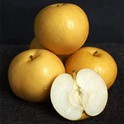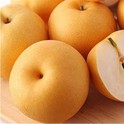Hey there, fellow fruit enthusiasts! I'm a supplier of Whasan Pear trees, and today I wanna chat about the pests and diseases that can mess with these beautiful trees. Whasan Pears are known for their juicy, sweet flesh and are a real treat for consumers. But just like any other crop, they're not immune to problems.
Let's start with the pests. One of the most common villains is the codling moth. These little critters lay their eggs on the fruit, and when the larvae hatch, they burrow into the pears. You'll often see small holes on the surface of the fruit, and if you cut it open, you might find the larvae munching away inside. This not only makes the fruit unappealing but also reduces its market value. To deal with codling moths, we usually use pheromone traps to catch the adult moths before they can lay eggs. We also apply insecticides at the right time to target the larvae.


Another pest that can cause trouble is the pear psylla. These tiny insects suck the sap from the leaves and shoots of the Whasan Pear trees. As they feed, they secrete a sticky substance called honeydew, which can lead to the growth of sooty mold. This mold covers the leaves and reduces the tree's ability to photosynthesize, affecting its overall health and productivity. We control pear psylla by using insecticidal soaps or oils, which suffocate the insects without harming the trees too much.
Aphids are also a nuisance. They cluster on the undersides of leaves and feed on the plant's sap. Like the pear psylla, they excrete honeydew, which attracts ants and can lead to sooty mold. Aphids can multiply rapidly, so it's important to keep an eye on them. We can use natural predators like ladybugs to control aphid populations, or we can apply insecticides if the infestation gets out of hand.
Now, let's talk about diseases. Fire blight is a serious bacterial disease that can affect Whasan Pear trees. It gets its name because the infected parts of the tree look like they've been burned. The bacteria enter the tree through wounds or natural openings, and they can spread quickly, especially in warm, wet weather. Infected branches wilt and turn black, and the fruit may also become infected. To prevent fire blight, we prune infected branches as soon as we notice them and disinfect our pruning tools between cuts. We also apply antibiotics during the bloom period to protect the flowers from infection.
Another disease is pear scab, which is caused by a fungus. It appears as dark, scaly lesions on the leaves, fruit, and twigs. These lesions can make the fruit unsightly and reduce its quality. Pear scab thrives in cool, wet conditions, so we try to improve air circulation around the trees by pruning and thinning the branches. We also apply fungicides to prevent the fungus from spreading.
Powdery mildew is yet another fungal disease that can affect Whasan Pear trees. It looks like a white, powdery coating on the leaves and shoots. This disease can reduce the tree's photosynthetic ability and weaken it over time. To control powdery mildew, we keep the trees well - watered and fertilized to maintain their health. We also apply fungicides when necessary.
It's important to note that different varieties of pears may have different levels of resistance to these pests and diseases. For example, the Autumn Moon Pear might have a different susceptibility compared to the Wonhwang Pear or the Fragrant Pear. As a supplier, we need to understand these differences so that we can provide the best care for our Whasan Pear trees.
At our place, we take a holistic approach to pest and disease management. We use a combination of cultural, biological, and chemical control methods. Cultural practices like proper pruning, watering, and fertilization help keep the trees healthy and more resistant to pests and diseases. Biological control methods, such as using natural predators, are environmentally friendly and can be very effective. And when necessary, we use chemical pesticides and fungicides, but we always follow the recommended application rates and safety guidelines.
If you're interested in purchasing Whasan Pears or learning more about our supply, we'd love to hear from you. Whether you're a grocery store owner, a restaurant chef, or just a pear lover looking to stock up, we can provide you with high - quality Whasan Pears. We take pride in our trees and the fruit they produce, and we're committed to delivering the best possible product to our customers. So, if you're thinking about a pear purchase, don't hesitate to reach out and start a conversation with us.
References
- Compendium of Apple and Pear Diseases, Second Edition. American Phytopathological Society.
- Integrated Pest Management for Stone and Pome Fruits. University Extension Publications.





